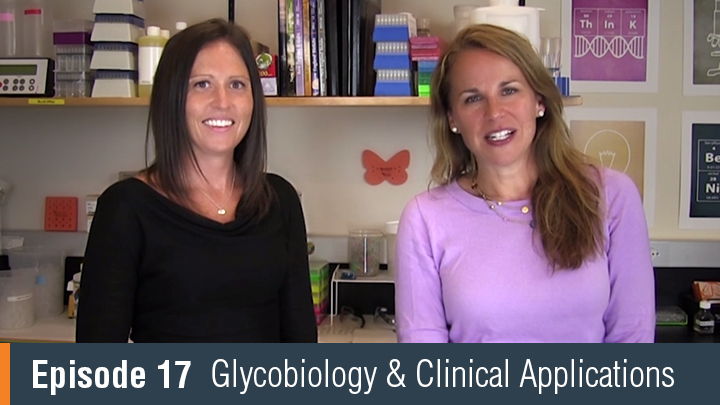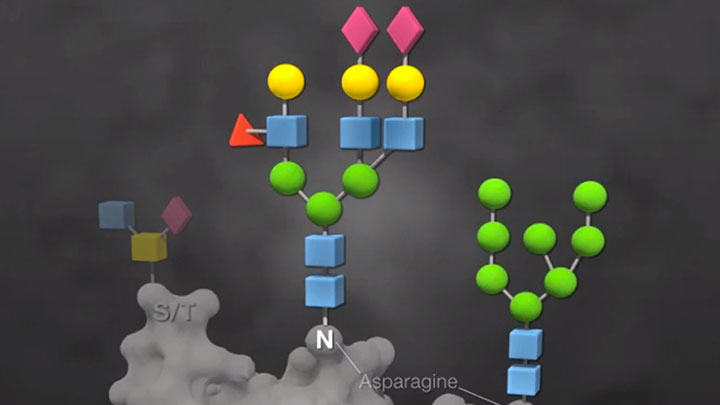
Glycobiology & Proteomics
Choose Type:
- What are Glycosidases and their uses?
- Which proteins are glycosylated?
- Can glycosidases be used in combination for extensive digestion?
- Can I analyze protein glycosylation with only benchtop instrumentation and reagents?
- Do I need to deglycosylate my protein sample for proteomic analysis?
- How can I separate a deglycosylated protein from the glycosidase?
- Is it possible to predict whether a protein is N- or O-glycosylated?
- What are the advantages of enzymatic deglycosylation?
- What are the best techniques to analyze N- and O-glycans?
- Glycan Analysis of Murine IgG2a by Enzymatic Digestion with PNGase F and Trypsin, Followed by Mass Spectrometric Analysis
- Detailed Characterization of Antibody Glycan Structure using the N-Glycan Sequencing Kit
- Remove iT PNGase F Effective Release and Recovery of Neutral and Sialylated N glycans
- Proteomics Fast and Efficient Antibody Deglycosylation using Rapid PNGase F
- Glycan Analysis of Murine IgG by Enzymatic Digestion with Endo S and PNGase F Followed by Mass Spectrometric Analysis
- Enzymatic Deglycosylation of a Protein Containing Core 1 O-glycans with O-Glycosidase
- Removal of terminal galactose from a glycoprotein containing tri- and tetra-antennary N-linked sugars with α1-3 6 Galactosidase
- Comprehensive structural and positional profiling of intact complex O-glycans in biologic drugs using O-Glycoprotease (IMPa)
-
The Structure, Function and Importance of Carbohydrates
Read about the structure, function, and importance of Carbohydrates from biology experts at NEB.
-
Using Glycosidases to Remove Trim or Modify Glycans on Therapeutic Protein
-
Glycomics: A rapidly evolving field with a sweet future
Glycans are widely distributed in nature and have physical, chemical, and biological properties that make them important players in areas such as biofuels, food, materials science, biotechnology, and pharmaceuticals.
-
N-Glycan Composition Profiling for Quality Testing of Biotherapeutics
- Glycoproteomics Brochure
- Glycoproteomics Technical Guide
- Rapid PNGase F Brochure
- Glycan Analyzer
- Endoglycosidase Selection Chart
- Detailed Characterization of Several Glycosidase Enzymes
- Glycobiology Unit Conversion Chart
- Improving Sample Workflow: Rapid PNGase F for Accurate Antibody Characterization (2015)
Feature Articles
Brochures
Web Tools
Selection Tools
Usage Guidelines
Posters
- Vainauskas, S., Kirk, C.H., Petralia, L., Guthrie, E.P., McLeod, E., Bielik, A., Luebbers, A., Foster, J.M., Hokke, C.H., Rudd, P.M., Shi, X., Taron, C.H (2018) A novel broad specificity fucosidase capable of core a1-6 fucose release from N-glycans labeled with urea-linked fluorescent dyes Sci Rep; PubMedID: 29934601, DOI: 1038/s41598-018-27797-0
- Chuzel, L.O., Ganatra, M.B., Rapp, E., Henrissat, B., Taron, C.H. (2018) Functional metagenomics identifies an exosialidase with an inverting catalytic mechanism that defines a new glycoside hydrolase family (GH156) J Biol Chem; 293(47), 18138-18150. PubMedID: 30249617
- O'Flaherty, Roisin, Harbison, Aoife M., Hanley, Philip J., Fadda, Elisa, Rudd, Pauline, Taron, Chris (2017) Aminoquinoline fluorescent labels obstruct efficient removal of N-glycan corex J Proteome Res; 16, 4237-4243.
- Albrecht, S., Vainauskas, S., Stöckmann, H., McManus, C., Taron, C.H. and Rudd, P.M. (2016) Comprehensive Profiling of Glycosphingolipid Glycans Using a Novel Broad Specificity Endoglycoceramidase in a High-Throughput Workflow. Anal Chem; May 3;88(9), 4795-802. Anal Chem.. PubMedID: 27033327
- Kwon HM, Lee KH, Han BW, Han MR, Kim DH, Kim DE (2014) An RNA aptamer that specifically binds to the glycosylated hemagglutinin of avian influenza virus and suppresses viral infection in cells PLoS One; 9(5), e97574. PubMedID: 24835440, DOI: 10.1371/journal.pone.0097574
- Wright CR, Brown EL, Della-Gatta PA, Ward AC, Lynch GS, Russell AP (2014) G-CSF does not influence C2C12 myogenesis despite receptor expression in healthy and dystrophic skeletal muscle Front Physiol; 5, 170. PubMedID: 24822049, DOI: 10.3389/fphys.2014.00170
- Itahana Y, Han R, Barbier S, Lei Z, Rozen S, Itahana K (2014) The uric acid transporter SLC2A9 is a direct target gene of the tumor suppressor p53 contributing to antioxidant defense Oncogene; PubMedID: 24858040, DOI: 10.1038/onc.2014.119
- Botto L, Cunati D, Coco S, Sesana S, Bulbarelli A, Biasini E, Colombo L, Negro A, Chiesa R, Masserini M, Palestini P (2014) Role of lipid rafts and GM1 in the segregation and processing of prion protein PLoS One; 9(5), e98344. PubMedID: 24859148, DOI: 10.1371/journal.pone.0098344
- Rosenbaek LL, Kortenoeven ML, Aroankins TS, Fenton RA (2014) Phosphorylation decreases ubiquitylation of the thiazide-sensitive cotransporter NCC and subsequent clathrin-mediated endocytosis J Biol Chem; 289(19), 13347-61. PubMedID: 24668812, DOI: 10.1074/jbc.M113.543710
- Haller G, Li P, Esch C, Hsu S, Goate AM, Steinbach JH (2014) Functional characterization improves associations between rare non-synonymous variants in CHRNB4 and smoking behavior PLoS One; 9(5), e96753. PubMedID: 24804708, DOI: 10.1371/journal.pone.0096753
- Arakel EC, Brandenburg S, Uchida K, Zhang H, Lin YW, Kohl T, Schrul B, Sulkin MS, Efimov IR, Nichols CG, Lehnart SE, Schwappach B (2014) Tuning the electrical properties of the heart by differential trafficking of KATP ion channel complexes J Cell Sci; 127(Pt 9), 2106-19. PubMedID: 24569881, DOI: 10.1242/jcs.141440
- Rosenbaum EE, Vasiljevic E, Brehm KS, Colley NJ (2014) Mutations in four glycosyl hydrolases reveal a highly coordinated pathway for rhodopsin biosynthesis and N-glycan trimming in Drosophila melanogaster PLoS Genet; 10(5), e1004349. PubMedID: 24785692, DOI: 10.1371/journal.pgen.1004349
- Stech M, Quast RB, Sachse R, Schulze C, Wüstenhagen DA, Kubick S (2014) A continuous-exchange cell-free protein synthesis system based on extracts from cultured insect cells PLoS One; 9(5), e96635. PubMedID: 24804975, DOI: 10.1371/journal.pone.0096635
- Wicht O, Burkard C, de Haan CA, van Kuppeveld FJ, Rottier PJ, Bosch BJ (2014) Identification and Characterization of a Proteolytically Primed Form of the Murine Coronavirus Spike Proteins after Fusion with the Target Cell J Virol; 88(9), 4943-52. PubMedID: 24554652, DOI: 10.1128/JVI.03451-13
- Zhao H, Blazanovic K, Choi Y, Bailey-Kellogg C, Griswold KE (2014) Gene and protein sequence optimization for high-level production of fully active and aglycosylated lysostaphin in Pichia pastoris Appl Environ Microbiol; 80(9), 2746-53. PubMedID: 24561590, DOI: 10.1128/AEM.03914-13
- Möykkynen T, Coleman SK, Semenov A, Keinänen K (2014) The N-terminal domain modulates α-amino-3-hydroxy-5-methyl-4-isoxazolepropionic acid (AMPA) receptor desensitization J Biol Chem; 289(19), 13197-205. PubMedID: 24652293, DOI: 10.1074/jbc.M113.526301
- Velho, A.M., Jarvis, S.M. (2009) Topological studies of hSVCT1, the human sodium-dependent vitamin C transporter and the influence of N-glycosylation on its intracellular targeting Exp Cell Res; 315 , 2312-21 . PubMedID: 19379732
- Gefter, J.V., Shaufl, A.L., Fink, M.P., Delude, R.L. (2009) Comparison of distinct protein isoforms of the receptor for advanced glycation end-products expressed in murine tissues and cell lines Cell Tissue Res; 337 , 79-89 . PubMedID: 19415334
- Boeggeman, E., Ramakrishnan, B., Pasek, M., Manzoni, M., Puri, A., Loomis, K.H., Waybright, T.J., Qasba, P.K. (2009) Site specific conjugation of fluoroprobes to the remodeled Fc N-glycans of monoclonal antibodies using mutant glycosyltransferases: application for cell surface antigen detection Bioconjugate Chem; 20 , 1228-36 . PubMedID: 19425533
- Gong, B., Cukan, M., Fisher, R., Li, H., Stadheim, T.A., Gerngross, T. (2009) Characterization of N-linked glycosylation on recombinant glycoproteins produced in Pichia pastoris using ESI-MS and MALDI-TOF Methods Mol Biol; 534 , 213-23 .
- Rasmussen, T.N., Plenge, P., Bay, T., Egebjerg, J., Gether, U. (2009) A single nucleotide polymorphism in the human serotonin transporter introduces a new site for N-linked glycosylation Neuropharmacology; 57 , 287-94 . PubMedID: 19500602
- Wagner-Rousset, E., Bednarczyk, A., Bussat, M.C., Colas, O., Corvaïa, N., Schaeffer, C., Van Dorsselaer, A., Beck, A. (2008) The way forward, enhanced characterization of therapeutic antibody glycosylation: comparison of three level mass spectrometry-based strategies J Chromatogr B Analyt Technol Biomed Life Sci; 872, 23-37. PubMedID: 18672411
- Graham, D.R., Mitsak, M.J., Elliott, S.T., Chen, D., Whelan, S.A., Hart, G.W., Van Eyk, J.E. (2008) Two-dimensional gel-based approaches for the assessment of N-Linked and O-GlcNAc glycosylation in human and simian immunodeficiency viruses Proteomics; 872, 23-37. PubMedID: 19072736
- Wong-Madden, S.T., Landry, D., and Guthrie, E.P. (1997) Discovery and Uses of Novel Glycosidases Techniques in Glycobiology; 401-408 .
Products and content are covered by one or more patents, trademarks and/or copyrights owned or controlled by New England Biolabs, Inc (NEB). The use of trademark symbols does not necessarily indicate that the name is trademarked in the country where it is being read; it indicates where the content was originally developed. The use of this product may require the buyer to obtain additional third-party intellectual property rights for certain applications. For more information, please email busdev@neb.com.
This product is intended for research purposes only. This product is not intended to be used for therapeutic or diagnostic purposes in humans or animals.



